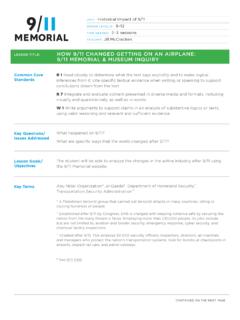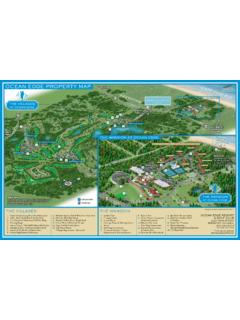Transcription of MUSEUM GUIDE FOR VISITORS WITH CHILDREN
1 This GUIDE has been created for parents and caregivers to help CHILDREN 8 to 11 years old understand the history of the World Trade Center, what happened on 9/11, and how the site has been rebuilt. Note that this GUIDE does not include the MUSEUM s historical exhibition, September 11, 2001, which may not be appropriate for VISITORS 10 years old and younger. For further questions, or more information, visit GUIDE FOR VISITORS with CHILDRENHOW TO USE THIS GUIDEEach artifact in the GUIDE is accompanied by age-appropriate questions you might pose to CHILDREN , along with basic background information for you to share. Questions that encourage CHILDREN to make observations and closely look at an artifact, such as What do you notice?, work especially well throughout the MUSEUM . The following pages include guidelines for how to talk about this complex subject and suggested answers to common questions about 9/11.
2 A glossary of Key Terms is located at the back of the is normal to have many questions about such a significant event. For people of any age, an encounter with the history of the attacks of September 11, 2001, can elicit strong emotions. These emotions can intensify when both CHILDREN and adults feel they do not have a complete understanding of what happened, making it more difficult to make sense of this history. Staff are stationed and available throughout the MUSEUM to provide more information or if you have a question that s difficult to answer. In addition, you can visit the education pages on our website, , for additional context and resources. 1 TIPS FOR TALKING TO CHILDREN ABOUT 9/11 Answer questions with facts. CHILDREN may have many questions about 9/11. Answer these questions with basic facts and point them to reliable sources, including our website , for further specific. It can be easy to make generalizations when discussing 9/11.
3 The story of 9/11 is actually thousands of individual stories. Highlight those stories and emphasize specificity to help humanize the history. Avoid stereotypes and oversimplifications. Listen. It is important to offer CHILDREN a safe space to share their memories, beliefs, and questions. Actively listen to their thoughts and encourage respectful conversation and debate. Insist that opinions be supported by evidence. Grounding discussions in evidence will promote critical thinking and help ensure that conversations remain yourself. Adults aren t immune to the emotions sparked by 9/11. Acknowledge and attend to your own reactions and feelings, memories, and connections. 9/11 is not an easy topic to think about, let alone discuss with a child. Recognizing your feelings beforehand and then sharing them honestly with your CHILDREN offers them a model for dealing with their own emotions and helps promote a safe, trusting environment.
4 We don t have all the answers. It s all right not to know the answer to every question. 9/11 is a complex subject with repercussions that are still evolving today. If you can t answer your child s question, be honest and use the opportunity to model yourself as a learner; you can explore the question together. 23 COMMON QUESTIONSWhat is 9/11? 9/11 is shorthand for a date, September 11, 2001. That day, 19 men hijacked four commercial airplanes. They intentionally flew three of the planes into buildings: the Twin Towers at the World Trade Center in New York City and the Pentagon, the headquarters for the armed forces of the United States, located just outside Washington, The Twin Towers ultimately collapsed because of damage from the impact of the hijacked planes. Hijackers turned the fourth plane off course and headed to Washington, , likely to be crashed into the Capitol building. The passengers and crew aboard that plane fought back, and the plane instead crashed into an empty field in western Pennsylvania.
5 Nearly 3,000 people were killed as a result of the 9/11 attacks, including people from more than 90 nations. What was the original World Trade Center? The original World Trade Center was a 16-acre complex in lower Manhattan, a busy part of New York City. The World Trade Center included seven buildings, a large plaza, and an underground shopping mall. Thousands of people worked and visited there every day. The centerpieces of the complex were the Twin Towers. On September 11, 2001, the entire World Trade Center was were the Twin Towers? The 110-story Twin Towers were the tallest buildings in New York City. For a brief period, they were the tallest buildings in the world. They were called the Twin Towers because they were nearly identical. You could tell them apart, though, because the North Tower had an antenna on its roof. The towers were well known throughout the world and famous for their size.
6 The North Tower, 1 WTC, stood 1,368 feet tall, and the South Tower, 2 WTC, stood 1,362 feet tall. On clear days, views could extend 45 miles from the top of 4the towers in every direction far enough to see all five New York City boroughs, New Jersey, and Connecticut. Why did the terrorists do this? The hijackers were terrorists, meaning that they used violence to try to frighten other people and impose a particular point of view. They belonged to a terrorist group called al-Qaeda. The terrorists hoped that by attacking important buildings in the United States and hurting many people, they would force the United States into changing its foreign policy, especially in the Middle East. Why is the MUSEUM located belowground? The MUSEUM is located belowground because remnants of the original World Trade Center buildings are still visible belowground, and it is the MUSEUM s job to preserve them so they can be seen by VISITORS like you.
7 In addition to these building remnants, the MUSEUM is filled with artifacts that help tell the story of 9/11. ARTIFACTSW orld Trade Center Tridents Location: Concourse LobbyThese two columns once formed part of the outside of the North Tower. We call them tridents because they fork into three columns near the top. Seventy-six of these tridents used to stand side by side to form the bottom of each of the Twin Towers. The columns forked around the fifth floor and then continued up the rest of the two buildings. You can see a picture of what they used to look like nearby. You might see the word SAVE written on the tridents. After 9/11, people wanted to make sure some objects from the World Trade Center were kept and protected for a possible future MUSEUM . They spray painted the word SAVE in big letters on those objects to make sure they were preserved. Describe the shape of these two objects.
8 What markings and words do you notice on them? Where do you think these objects came from?5 Box Column Remnants Location: North and South Tower footprints What shape are these objects? Why do you think they line the floor throughout this level of the MUSEUM ?The Twin Towers were so tall and so heavy they had to be anchored into a special kind of rock strong enough to support their weight. This solid rock is called bedrock. You can see actual bedrock in the South Tower perimeter columns that held up the Twin Towers were attached to bedrock, just like roots support a tree. These columns are called box columns because of their shape they re hollow and square. From bedrock, they rose to form the tridents you might have seen on the Concourse Lobby level. After the towers collapsed on 9/11, most of the box columns aboveground were destroyed. But some remained standing and were eventually cut down to clear the site.
9 What you see in the floor are the bottom sections of the columns, which continue down below the floor, where they are still bolted to bedrock. Around the North Tower footprint, these rows of squares trace most of the actual outline of the original building. A portion of the South Tower footprint can also be seen in the of the Radio and Television Antenna Location: Center Passage What do you think this object is? Where do you think it came from?This is a piece of a 360-foot antenna that used to sit atop the North Tower. The antenna was as tall as a football field is long. It was the easiest way to tell the Twin Towers apart, since the South Tower did not have one. This antenna once broadcast radio and television signals all over the New York City area. All transmissions stopped on 9/11 when the tower collapsed, so TV and radio stations used other antennas in the area to let people know what was Company 3 Fire Truck Location: Center Passage What kind of vehicle is this?
10 What differences do you notice between the front and the back of this truck? Can you find a helmet near the truck?This fire truck belonged to a firehouse in Manhattan, New York City Fire Department (FDNY) Ladder Company 3. On 9/11, rescue workers, including the firefighters from Ladder Company 3, immediately rushed to help those who were trapped or hurt at the World Trade Center. These men and women ran toward the buildings when most people were running away. We call these rescue workers first first responders came from many firehouses, police stations, hospitals, and other locations. They rushed to the scene to help those inside the burning towers. That was their job. Sadly, many first responders were killed on 9/11 when the towers collapsed. This Ladder Company 3 truck was damaged by the collapse of the North Tower. On the side of the truck you can see a helmet that belonged to Ladder Company 3 s captain, Patrick John Brown, who was killed on 9/11.


